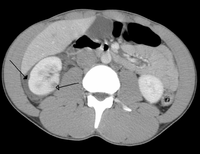
Photo from wikipedia
BACKGROUND/PURPOSE In hepatobiliary and pancreatic (HBP) surgery, the role and significance of intra-abdominal lavage (IAL) for surgical site infection (SSI) is controversial. METHODS This prospective study was performed between July… Click to show full abstract
BACKGROUND/PURPOSE In hepatobiliary and pancreatic (HBP) surgery, the role and significance of intra-abdominal lavage (IAL) for surgical site infection (SSI) is controversial. METHODS This prospective study was performed between July 2020 and July 2022. A total of 150 patients, 10-L IAL was performed. The lavage fluid at 1-L, 5-L, and 10-L was subjected to bacterial culture examination. Risk factors for SSI were evaluated. RESULTS Bacterial positivity rate significantly decreased as follows: 1-L, 36% (n=54); 5-L, 27% (n=41); 10-L, 23% (n=35) (36% vs. 23%, P=0.001). Patients with positive lavage fluid culture at 10-L had significantly higher incidence of both incisional (37% vs. 6%, p<0.01) and organ/space (54% vs. 3%, p<0.01) SSI. Multivariate analysis revealed positivity for bacterial culture at 10-L as the strongest independent risk factor for incisional SSI (OR 13.0, 95%CI 3.86-43.6, p<0.01), followed by postoperative pancreatic fistula (OR 11.7, 95%CI 3.03-45.6, P<0.01). Likewise, in organ/space SSI, positivity for bacterial culture at 10-L was the strongest independent risk factor (OR 48.9, 95%CI 12.1-197.7, p<0.01), followed by digestive reconstruction (OR 5.20, 95%CI 1.45-18.6, p=0.01). CONCLUSION IAL decreased intraperitoneal contamination rate in a volume-dependent manner and can be useful in surveillance of SSI development in HBP surgery.
Journal Title: Journal of hepato-biliary-pancreatic sciences
Year Published: 2022
Link to full text (if available)
Share on Social Media: Sign Up to like & get
recommendations!